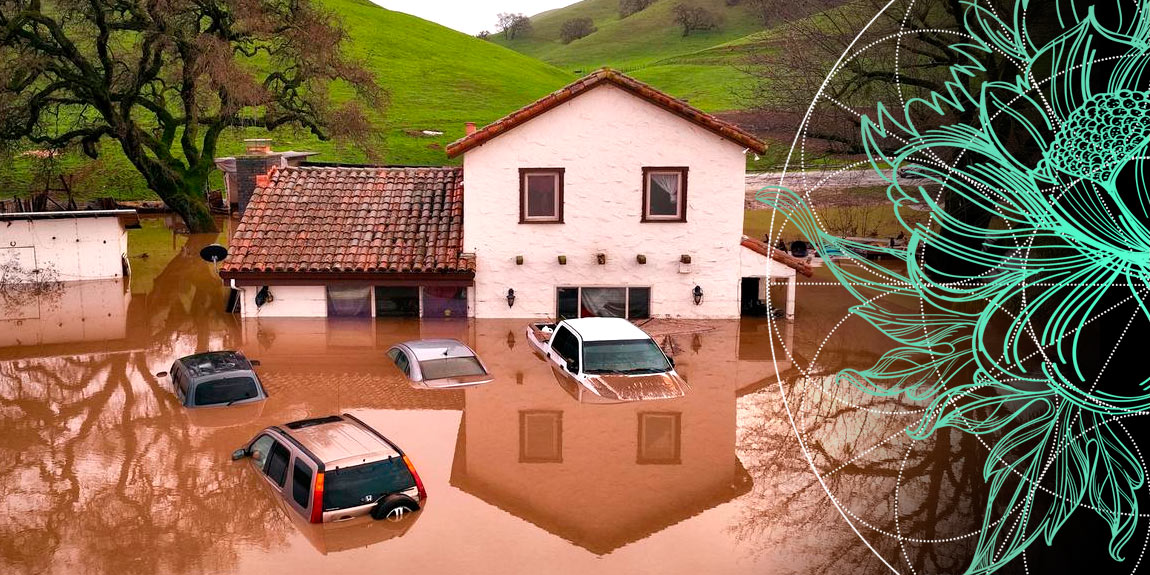As private flood insurance accounts for over 40% of California’s entire flood market—a significantly larger share than in the other leading states—the ongoing flooding issues in the state will present a good test for the private flood insurance market, according to AM Best.
The extreme weather that has bombarded California with deadly rain and winds since late December has left neighborhoods under water, downed trees, and caused mudslides.
This series of storms has been transported by an “atmospheric river,” a relatively narrow, windy region of the Earth’s atmosphere that can transport moisture for miles, like a river on land does water (see about Role for Re/Insurers in Building Flood Resilience).
Unfortunately for Californians, these storms are battering the state after a decades long drought in both the state and the surrounding region.
Despite the unrelenting rain, the ground is unable to soak up the water because of the prolonged drought and devastating wildfires—hence, the historic flooding and mudslides currently plaguing the state.
With the extreme weather continuing into mid-January, it is too early to begin calculating the cost of damage to homeowners and businesses across the state, but the cost is ultimately expected to be in the billions.
AM Best estimates that 98% of California residents are not insured for direct flood exposures. These storms in California and the ongoing flooding will therefore shine a spotlight on private flood insurance.
Homes remain underinsured

The inadequacy of the National Flood Insurance Program’s (NFIP) rates has been apparent for some time. This points to an opportunity for a robust private flood insurance market.
NFIP’s newly implemented Risk Rating 2.0 increased the potential for more private insurers to provide flood insurance options outside the federal program, and this seems to have taken hold in California.
Of the states with at least $100m of direct premiums written in flood insurance, California has the largest share of premium written by the private market, at 41%, compared with 24% nationally.
At the same time, just 2% of California residents have purchased flood insurance, and the state’s NFIP policies represent just 4% of the NFIP’s total policies despite the state representing approximately 12% of the US population (see Global Natural Catastrophe Economic & Insured Losses).
These percentages indicate that the preponderance of the flood losses suffered by homeowners and businesses will not be covered by insurance.
Homes in California protected by NFIP insurance may still be underinsured, given that NFIP insurance is limited to $250,000 per residence, well below California’s median home value of nearly $685,000, the second-highest in the country.
National Flood Insurance Program had paid $2.2 billion in claims for Hurricane Ian an increase of almost 28%
US Federal Emergency Management Agency (FEMA) has now provided $896 million to households impacted by Ian, and $504 million to the State of Florida for emergency response to the storm.
FEMA reported that $1.2 billion has gone to NFIP policyholders to help their Hurricane Ian recovery, with over 46,000 policyholders having filed claims following the storm’s landfall.
More than $237 million of those dollars were in the form of advance payments, where policyholders could receive up to $20,000 after filing a claim. Over 10,000 policyholders received advance payments as they worked their claims.
Private flood insurance market opportunities

Many homes covered by the NFIP would benefit from an excess policy above the NFIP coverage limit, so opportunities abound for private flood insurers willing to take the risk.
Historically, private flood insurance has been profitable for California’s top private flood writers, but the extensive damage from the current storms may be enough to wipe out several years of good results.
The commentary also notes the regulator’s directive to insurers stating that mudslides, which are typically covered by flood insurance, are to be covered under a homeowners or other property policy as a fire loss if the hill in which the mudslide emanated was previously weakened by fire.
Although the total economic loss would be unaffected, the decree may shift some losses from flood policies to other property policies.
Flooded California looks for new ways to deal with drought

A series of storms flooded California for weeks, and yet drought conditions persist. Could allowing flooding in the right places be a solution to water shortages?
The huge storms that soaked the US state over most of the last month have passed, leaving behind at least 20 dead, breached levees, destroyed homes and at least $1 billion in damage.
California’s existing groundwater replenishment projects, common in the fertile Central Valley and the southern part of the state, generally use dedicated recharge basins. These basins look like large swimming pools or artificial lakes and collect water during wetter periods, said Peterson.
But older basins may not be built to handle such large flows of floodwater, and can require expensive maintenance and refurbishment.
Flood-managed aquifer recharge, however, often goes beyond these basins and involves allowing agricultural and open fields to be inundated. The water is left to soak into the natural underground reservoirs, where it is held back for later use.
In contrast to using dedicated recharge basins, this approach opens up groundwater replenishment to any suitable site — while at the same time helping to reduce the risk of flooding elsewhere. It also lessens the need for canals and other infrastructure to get the water to purpose-built basins.
…………………….
AUTHOR: Christopher Graham – Senior Industry Analyst at AM Best








